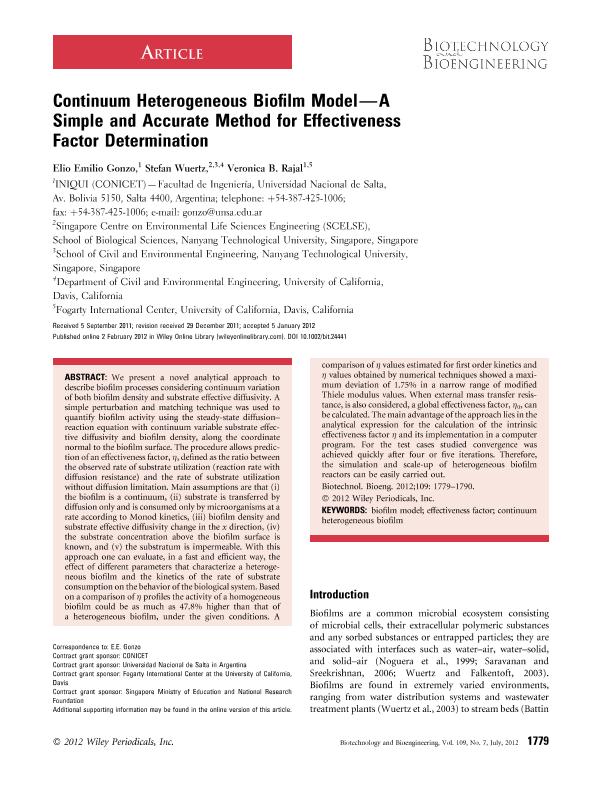Artículo
Continuum heterogeneous biofilm model-A simple and accurate method for effectiveness factor determination
Fecha de publicación:
07/2012
Editorial:
Wiley VCH Verlag
Revista:
Bioengineering And Biotechnology
ISSN:
0006-3592
e-ISSN:
1097-0290
Idioma:
Inglés
Tipo de recurso:
Artículo publicado
Clasificación temática:
Resumen
We present a novel analytical approach to describe biofilm processes considering continuum variation of both biofilm density and substrate effective diffusivity. A simple perturbation and matching technique was used to quantify biofilm activity using the steady-state diffusion-reaction equation with continuum variable substrate effective diffusivity and biofilm density, along the coordinate normal to the biofilm surface. The procedure allows prediction of an effectiveness factor, η, defined as the ratio between the observed rate of substrate utilization (reaction rate with diffusion resistance) and the rate of substrate utilization without diffusion limitation. Main assumptions are that (i) the biofilm is a continuum, (ii) substrate is transferred by diffusion only and is consumed only by microorganisms at a rate according to Monod kinetics, (iii) biofilm density and substrate effective diffusivity change in the x direction, (iv) the substrate concentration above the biofilm surface is known, and (v) the substratum is impermeable. With this approach one can evaluate, in a fast and efficient way, the effect of different parameters that characterize a heterogeneous biofilm and the kinetics of the rate of substrate consumption on the behavior of the biological system. Based on a comparison of η profiles the activity of a homogeneous biofilm could be as much as 47.8% higher than that of a heterogeneous biofilm, under the given conditions. A comparison of η values estimated for first order kinetics and η values obtained by numerical techniques showed a maximum deviation of 1.75% in a narrow range of modified Thiele modulus values. When external mass transfer resistance, is also considered, a global effectiveness factor, η 0, can be calculated. The main advantage of the approach lies in the analytical expression for the calculation of the intrinsic effectiveness factor η and its implementation in a computer program. For the test cases studied convergence was achieved quickly after four or five iterations. Therefore, the simulation and scale-up of heterogeneous biofilm reactors can be easily carried out. © 2012 Wiley Periodicals, Inc.
Palabras clave:
BIOFILM MODEL
,
CONTINUUM HETEROGENEOUS BIOFILM
,
EFFECTIVENESS FACTOR
Archivos asociados
Licencia
Identificadores
Colecciones
Articulos(INIQUI)
Articulos de INST.DE INVEST.PARA LA INDUSTRIA QUIMICA (I)
Articulos de INST.DE INVEST.PARA LA INDUSTRIA QUIMICA (I)
Citación
Gonzo, Elio Emilio; Wuertz, Stefan; Rajal, Verónica Beatriz; Continuum heterogeneous biofilm model-A simple and accurate method for effectiveness factor determination; Wiley VCH Verlag; Bioengineering And Biotechnology; 109; 7; 7-2012; 1779-1790
Compartir
Altmétricas




